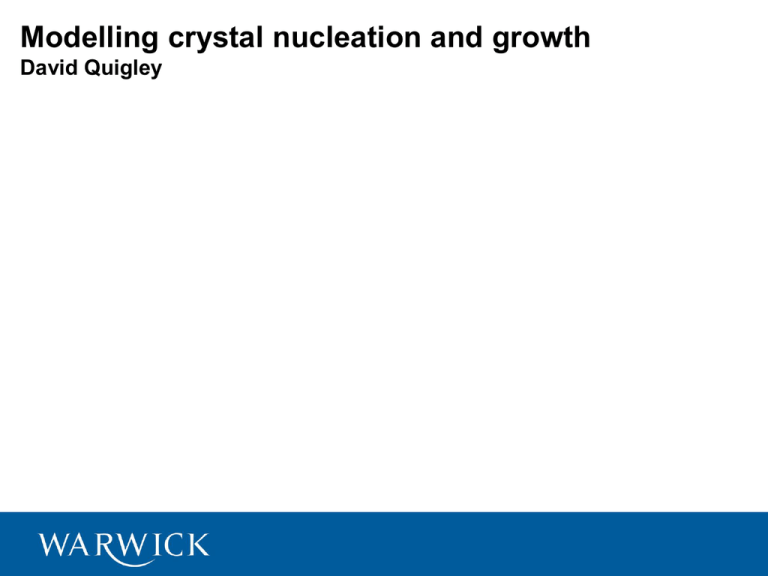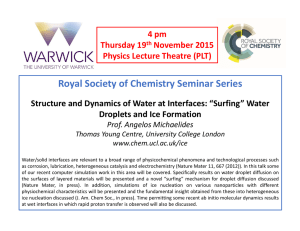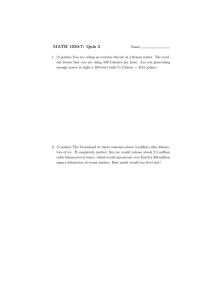Modelling crystal nucleation and growth David Quigley
advertisement

Modelling crystal nucleation and growth David Quigley Overview • Why study nucleation? • Strategies for atomistic nucleation • How quantitative can we be and under what circumstances? • Polytypes and stacking disorder in ice nuclei • Nucleation via metastable phases - ice 0 Motivation Sheets of aragonite tablets https://www.youtube.com/watch?v=0JtBZGXd5zo Mollusc shells Nudelman et al Faraday Discuss. 136, 9-25 (2007) Columns of calcite [Vedre et al Atherosclerosis, March 2009, Abela et al American Journal of Cardiology, April 2009] Classical nucleation theory (CNT) Energy benefit (bulk) : Energy penalty (surface) : Classical nucleation theory (CNT) Nucleation rates connect directly to experiment Diffusivity of Density of liquid Zeldovich factor, related to curvature at barrier top For spherical nuclei Strategies for computer simulation Use classical nucleation theory (CNT) 1. Use biased sampling (MD/MC) method to measure 2. Fit and 3. Simulate at to resulting curve to calculate and compute and from MSD of Requires specialist codes, but structure of critical nucleus extracted from the MD/MC Useful when barrier is high and dynamics are slow and diffusive Reinhardt, A. & Doye, J. P. K. J. Chem. Phys., 2012, 136, 054501 Strategies for computer simulation Use classical nucleation theory (CNT) 1. Run swarms of standard MD trajectories with seed nuclei of size 2. Compute mean drift velocity 3. Identify 4. Compute 5. Fit and as at each with zero mean drift from gradient of to CNT at using Requires assumption of particular nucleus structure, but only off-the-shelf MD codes Useful when barrier is high, and dynamics are slow and diffusive Knott et al. J. A. C. S., 2012, 134, 19544 Strategies for computer simulation Brute force molecular dynamics simulation Useful when barrier is low and dynamics are fast B. Vorselaars and DQ, in preparation 2015 Strategies for computer simulation Use a transition path sampling method 1. Count the rate at which some small is reached 2. Use specialist methods (FFS/TIS) to sample pathways crossing 3. Determine fraction of these pathways which reach solid phase Various attempts to implement as wrapper to standard MD packages, however how best to compute is an issue Useful when barrier is high and dynamics are fast enough to sample a large number of trajectories Li et al PCCP., 2011, 13, 19807 Modelling water Short-ranged two and three-body potential Nucleation simulations with mW • Forward Flux Sampling from 220K to 240K • Critical nuclei contain ~ 50% cubic • Brute force molecular dynamics at 180K • Critical nuclei ~ 66% cubic • Umbrella sampling Monte Carlo at 220K • Critical nuclei “predominantly cubic” Ice 1 has two polytypes Hexagonal ice 1h Cubic ice 1c Layers stack as ABABABA….. Layers stack as ABCABCABC… Growing ice from supercooled water Malkin et al. P.N.A.S. (2012) 273.15 200 180 120 Temperature (Kelvin) Hexagonal Ice Ice homogeneously nucleated at low temperatures is stacking disordered. NOT cubic OR hexagonal but a mixture. Stacking fault statistics in nuclei • Stacking model • E.g. L = 5 Δg = free energy difference per molecule between cubic and hexagonal ice. Nl = molecules per layer. Sequence Energy Entropy ABABA ABCBC ABACA 0 Nl Δg 0 kln(2) ABCAC ABCBA ABCAB 2Nl Δg kln(2) 3Nl Δg 0 (Removing sequences identical under cyclic permutations of labels or reversal) of t his paper is con ΔG and classical nucleation theory ∆ Ghc for t he molecu employed in ice nuc els molecules t o correctly repro • Expectation of % cubic polytypes in critical FIG. 1: Averagepercentageof moleculesin cubic layers within FIG. 1: Averagepercenta show CNT estimate of critical t o assess t heir suita ice nuclei of size N• atPoints temperature T according to the stack ice nuclei of size N at −te1 nucleus size using: st udies. verage percent age of molecules in cubic layers wit hin ing model described in the text with ∆ Gh c = 50J molin ing model described of size N at t emperat ure T denote according o t he st nucleus ackOpen circles thetcritical size predicted by clas − 1 Open circles denote the c described in t he t ext wit h ∆ Gh c = 50J mol . -1 sical nucleation theory using γsl = sical 33mJnucleation m− 2 and ∆ H fus u = ΔG = 30 J mol theory es denot e t he crit ical nucleus ed by clasMW − 1 size predict − 2 6.01kJ mol . − 1 eat ion t heory using γsl = 33 mJ m and ∆ H = 6.01kJ mol . ol −1 fus . The mW model w t er molecule is repre Units: layer therefore increases toward the centre the nucleus t eract sofwit hincrease it s neigh layer therefore efore increases t oward t he cent re of the nucleus. t erms, lathc ter, favo Experimental estimates for ∆ GExperimental =pertNhe δg the -1 ≈ 0.0001 hc AO 10 J mol eV H estim 2 ment al ΔG estimat es for ∆ Ghc = N A δghc , t he -1 ronment s. In(200K) t hetwo ab = 50 J mol Gibbs free energy di↵erence per mole between the ≈ 0.006 k T per H O B 2 free energy ice di↵e ee energy di↵erence per mole between t he two Gibbs and hexagonal p polytypes, are obtained from the heat evolved ∆ H on hc s, are obt ained from t he heat evolved ∆ H hc on polytypes, arelonsdalit obtainede mond and cubic iceto hexagonal ice. Measurementso ming cubic ice transforming to hexagonal ice. Measurements of transforming cubic conduct ors. Theicet me ∆ H measurement are varied.s span Several span the range e varied. Several themeasurements range Lattice switching Monte Carlo • 200K, 64 molecule unit cells 20 P(m) bh(m) 30 10 0 -400 -200 0 m 200 • 200-400 times faster than TIP4P 400 DG / J mol -1 40 38 36 34 cubic (diamond) 32 30 0 5 10 15 20 MC sweep / 10 25 6 30 hexagonal (lonsdalite) Finite size effects at 200K 40 -1 30 DG / J mol 20 10 0 -10 -20 0 0.02 0.04 1/N ΔG = 0.4 to 2.6 J mol-1 in thermodynamic limit c.f. published estimate 0 ± 30 J mol-1 (Moore and Molinero PCCP 2011) 0.06 Temperature dependence • N = 384 P(m) T = 180 K T = 240 K -2000 -1000 cubic 0 m 1000 2000 hexagonal T (K) ΔG / J mol-1 180 2.47(3) 200 4.15(2) 220 3.55(3) 240 5.77(4) Comparison of stacking energetics • mW has almost exactly zero penalty for formation of cubic stacking faults • Will nucleate stacking disordered ice at all temperatures ΔG = 30 J mol-1 Li, Donadio & Galli 2011 Reinhardt & Doye 2011 Moore & Molinero 2011 mW DQ J. Chem. Phys. 2014, 141, 121101 ARTICLES ICLES PUBLISHED ONLINE: 18DOI: MAY10.1038/ 2014 | DOI: 10.1038/ NMAT3977 NATUREMATERIALS NMAT3977 a New metastable form of ice and its role in the homogeneous crystallization of water John Russo1†, Flavio Romano1,2† and Hajime Tanaka1* Ice Ih Ice Ic Clathrate (HS-III) Ice 0 P (kbar) The b homogeneous crystallizationcof water at low temperature is believed to occur through the direct nucleation of cubic (I c) and hexagonal (I h) ices. Here, we provide evidence from molecular simulations that the nucleation of ice proceeds through the formation of a new metastable phase, which we name Ice 0. We find that Ice 0 is structurally similar to the supercooled 10 liquid, and that on growth it gradually converts into a stacking of IceIce Ic Icand Ice 0 / Ih I h. We suggest Liquidthat this mechanism provides a thermodynamic explanation for the location and pressure dependence of the homogeneous nucleation temperature, and that Ice 0 controls the homogeneous nucleation of low-pressure ices, acting as a precursor to crystallization in accordance with Ostwald’s step rule of phases. Our findings show that metastable crystalline phases of water may play roles that have been 5 largely overlooked. T b DF + shift b DF (n) he crystallization of water into ice 0is the most ubiquitous arrangement of nearest neighbours. Thelocally tetrahedral structure and important freezing transition on Earth, playing a central of water iscompatiblewith alargevariety of crystal structures, which role in many scientific and technological fields1–4 such as despiteCS-II being metastable with respect to the I h and I c crystals can atmospheric ice cloud formation, geological processes such as frost be reflected in the structure of the supercooled liquid state and 150 heaving, and biological ones such as freezing-induced cell-damage have200 a significant effect250 on the nucleation pathway of ice. To assess Ice 0 unit cell (K) and food preservation2,5–8. In the case of ice clouds, for example, it theTimportance of metastable crystal phases we have undertaken a isdbelieved that ice crystallites in the atmosphere can form through systematic investigation of the thermodynamic stability of several e 40 P = 3,1 40 bar; T = 206.2 K homogeneous nucleation in pre-existing liquid aerosols. Water also tetrahedral crystalline structures (F. R., J. R. and H. T., manuscript 50 P = 6,280 bar; T =to 196.5 K crystallization, becausepurewater showsasurprisingability resist in preparation), borrowed from the known crystalline phases of can be easily supercooled far below its melting temperature; water group 14 elements and four-coordinated compounds. We have 30 40 dropletshaveindeed been found in deep convectivecloudsdown to found that one such structure, a recently proposed allotrope for ◦ − 37.5 C (ref. 6). At even lower temperatures, alimit of supercooling silicon, carbon and germanium called T12 (ref. 24), is also a 30 is reached, called the homogeneous nucleation line, below20which mechanically stable phase for two of the most popular models of water20undergoes rapid crystallization. Why liquid water has such a water, mW (monoatomic water) and TIP4P/2005. A representation P = 0 bar large temperature range of metastability, and what determines the of the crystal structure is shown in Fig. 1b, where the oxygen P = 3,140 bar 10 P = 0 bar; T = 215.2 K slopeof thehomogeneous-nucleation lineasa function of pressure, atoms occupy the positions of the T12 structure and the hydrogens 10 P = 3,140 bar; T = 194.7 K P = 6,280 bar arestill unanswered questions. form a disordered network of hydrogen bonds according to the P = 6,280 bar; T = 171.0 K Crystallization of deeply supercooled water has been studied Bernal–Fowler rules for water 1. The unit cell is tetragonal and 0 0 9,100 60 molecules. 80 100 we report a crystallization 0 20by freezing 40 60 80 100 experimentally water inside nanopores , by 20 contains4012 water Here, decompression or warming ofn high-pressure ices11,12, by solutions scenario for nwater centred around this metastable form of ice of electrolytes13, or inside water droplets emulsified in an oil that we call Ice 0 (we provide an in-depth characterization of 14–16 ice phase and its role in the mW phase diagram. a, Crystal phases relevant to crystallization in order (from left to right) of new metastable matrix . Diffraction patterns from these experiments showed its structural and crystallographic properties in Supplementary chemical potential in the supercooled region at ambient b, Representation the tetragonal cellthat of Ice 0. 0 Oxygen atoms (red peaksthat deviatefrom what isexpected from pressure. thepurecubic (I c) or of Section I). Weunit show Ice has several structural features close ccupy the positions the T12 crystal hydrogen atoms areand placed randomly to the Bernal–Fowler rules. Hydrogen hexagonal (I h )ofice phases, andstructure revealedwhereas a stacking of hexagonal to thoseaccording of liquid water, and argue that it is this ‘friendliness’ 17 shown as yellow lines to between a pair of oxygen atoms within unit cell boxwith (greenthe lines). c, P–Tthat phasemakes diagramthis of mW water. cubic layersdashed . Owing the experimental difficulties inthe accessing liquid ice polymorph important in s lines the liquid and di erent which crystal structures: Ice Iinitial Ice 0 (red) and clathrate CS-II (green). h / Ic (blue), theindicate short coexistence time and between length scales of phase ice nucleation, is an the liquid-to-crystal transformation process. We also show Is ice 0 real? Slater, B. & DQ Crystal nucleation: Zeroing in on ice Nat. Mater., 2014, 13, 670-671 DQ; Alfè, D. & Slater, B. J. Chem. Phys., 2014, 141, 161102 Summary • Quantitative (if inaccurate) calculation of nucleation rates from molecular simulation is becoming possible for ‘real’ systems.. • .. provided (very) cheap models are available. • Unlikely to be be predictive for some time, but trends should be accessible. • Quantifying sources of error likely to be very challenging. • Existing simulations do open up new questions! Acknowledgements Ice 0 stability Ben Slater (UCL) Dario Alfé (UCL)




